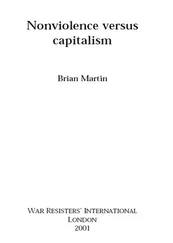There is another aspect to the peace movement’s hostility to civil defence: it undercuts the common belief in the movement and the wider society that nuclear war is not survivable. In peace movement circles it has long been an article of faith that global nuclear war would mean at least the destruction of “civilisation” and possibly the extermination of the human species. On the other hand, most civil defence and military planners believe that nuclear war — while being a major and perhaps unprecedented disaster — could be waged without killing the majority of the world’s population or destroying the capacity of societies to continue functioning. My own view is that the civil defence and military planners are probably right. Peace movement exaggerations of the consequences of nuclear war may serve to make people more worried in the short term, but can actually be paralysing and certainly make it more difficult to mobilise people for the long-term struggles to build alternatives to the military system. Needless to say, these views are controversial. [1] . See Brian Martin, “Critique of nuclear extinction,” Journal of Peace Research , Vol. 19, No. 4, 1982, pp. 288-300; Brian Martin, “How the peace movement should be preparing for nuclear war,” Bulletin of Peace Proposals , Vol. 13, No. 2, 1982, pp. 149-159 (revised versions of these articles appear in Brian Martin, Uprooting War (London: Freedom Press, 1984), chapters 15 and 16); Brian Martin, “Politics after a nuclear crisis,” Journal of Libertarian Studies , Vol. 9, No. 2, Fall 1990, pp. 69-78. See also Michael Curry, “Beyond nuclear winter: on the limitations of science in political debate,” Antipode , Vol. 18, No. 3, 1986, pp. 244-267; Barry Richards, “Civil defence and psychic defence,” Radical Science 15 , 1984, pp. 85-97.
My main point here is that supporters of nonviolent struggle should be willing to consider taking and adapting ideas from the field of civil defence without being put off by its usual associations with military planning.
As noted before, most civil defence planning is undertaken by governments. Furthermore, it is designed against “foreign” aggression. What is really needed for nonviolent struggle is defence against any aggressor, including the government itself. It should be no surprise that governments do not spend much time helping their populations develop the means to resist and survive the government’s own repressive acts. Nor is there much study of this. There is much to learn from people’s improvised resistance to attack.
The best study I know of this sort is Barton Meyers’s article “Defense against aerial attack in El Salvador,” [2] . Barton Meyers, “Defense against aerial attack in El Salvador,” Journal of Political and Military Sociology , Vol. 22, Winter 1994, pp. 327-342. I thank Mary Cawte for pointing out this reference.
which gives many specific insights. To survive bombing from El Salvador’s air force, both civilians and guerrillas developed and used a range of methods. No sophisticated warning systems were available, so people had to develop their own skills in detecting and identifying aircraft. When spotter planes were seen, people froze in place so they wouldn’t be seen; any moving target was subject to attack. When the spotter plane changed course, people would seek shelter, sometimes setting off a firecracker to warn others.
Concealment was widely used. Leafy trees were grown next to houses to hide them. Houses that were partly destroyed were left unrepaired to hide the fact that they were still being lived in. At the sound of aircraft, fires were quickly doused; alternatively, underground ovens were used with long tunnels to absorb smoke. Radio transmissions were not used by guerrillas to avoid being intercepted. Peasants wore dark clothing to avoid detection. They grew crops whose colour was not readily noticeable from the air and crops that were hidden by other plants.
Shelters were built and disguised. Natural features, such as forests and ravines, were also used for shelter. Guerrillas built extensive tunnel systems. In areas subject to frequent attack, shelter drills were carried out. When the government army invaded following air attack, guerrillas often would lead an evacuation of the population, returning later.
The guerrillas, in the face of heavy air attack, dispersed their forces to groups of 4 to 15 fighters spread out over hundreds of meters. Larger units would have been more vulnerable to air power. The dispersed fighters were concentrated only for attacks or briefly at night. Another tactic was to deploy the guerrillas very near to government troops, where aerial attack might harm the government’s own soldiers.
As well as methods of surviving attack, other techniques of struggle were used, such as broadcasting reports of deaths or injuries of civilians due to air attack. Such human rights appeals were highly effective, and would be even more so in the context of a purely nonviolent resistance.
There is a great need for many more studies like that of Meyers, as well as a need to circulate the findings to people who can use them. Unfortunately, the contemporary field of disaster studies has neglected the study of war as a disaster. One factor behind this may be that most war disasters occur in poor countries whereas disaster studies are largely carried out in the rich countries which sponsor and provide weapons for these wars. [3] . Barton Meyers, “Disaster study of war,” Disasters , Vol. 15, No. 4, December 1991, pp. 318-330.
As well as knowing how to respond to aerial attack, there are many other areas in need of investigation, including firearms, landmines, biological agents, chemical weapons and nuclear weapons. A first step would be to provide basic technical information that is accessible to nonspecialists and which can be used to provide a realistic assessment of dangers and possibly to expose uses of the weapons. [4] . Examples of useful sources of this sort are Christopher T. Carey, “Defense against the poor man’s nuclear bomb: biological protection and decontamination,” American Survival Guide, Vol. 20, No. 6, June 1998, pp. 32-33, 58-59 and 68; Hugh D. Crone, Banning Chemical Weapons: The Scientific Background (Cambridge: Cambridge University Press, 1992).
Yet another entire field is “repression technology,” which includes instruments of restraint, intimidation, torture and surveillance, ranging from plastic bullets, chemicals such as mace, leg irons, thumbscrews, drugs for causing trauma, assassination rifles, batons, electroshock equipment, telephone taps, vehicle identification, and execution chambers. There is a large industry devoted to producing and selling such technologies, yet very little in the way of analysis.
Repression technologies can be used by police as well as military personnel. While some of these technologies are designed to kill, others are intended to hurt or restrain people without killing them. These are referred to as “nonlethal weapons.” [5] . John B. Alexander, Future War: Non-Lethal Weapons in Twenty-First-Century Warfare (New York: St. Martin’s Press, 1999); Malcolm Dando, A New Form of Warfare: The Rise of Non-Lethal Weapons (London: Brassey’s, 1996); Nick Lewer and Steven Schofield, Non-Lethal Weapons: A Fatal Attraction? Military Strategies and Technologies for 21st-Century Conflict (London: Zed Books, 1997); David A. Morehouse, Nonlethal Weapons: War Without Death (Westport, CT: Praeger, 1996).
Some of these nonlethal weapons are designed to disable lethal weapons and their support systems, such as bugs to put in fuel to eat away linings, hydrogen embrittlement of weapons, antitraction technologies, supercaustics, combustion modifiers and computer viruses. These could be used, in principle, as part of nonviolent sabotage. However, the larger category of nonlethal weapons is aimed at personnel and are designed for riot control or counterinsurgency.
Читать дальше












